Peer support groups play a crucial role in enhancing mental health by providing emotional support and fostering a sense of belonging. They typically consist of small, diverse groups that follow a structured format to facilitate sharing and connection. Different types of peer support groups cater to specific needs, influenced by regional cultural norms and accessibility. Establishing these groups requires clear objectives and a safe environment to ensure effective support for participants.

What are the key benefits of peer support groups for mental health?
Peer support groups provide emotional support, foster a sense of belonging, and enhance coping strategies for mental health. Participants share experiences, reducing feelings of isolation. These groups often lead to increased self-esteem and empowerment, as members gain insights from one another. Research indicates that peer support can significantly improve overall well-being and resilience in individuals facing mental health challenges.
How do peer support groups enhance emotional well-being?
Peer support groups significantly enhance emotional well-being by providing a sense of community and shared experience. Participants often report increased feelings of belonging and reduced feelings of isolation. These groups foster open communication, allowing members to share their struggles and coping strategies, which can lead to improved mental health outcomes. Research indicates that individuals involved in peer support experience lower levels of anxiety and depression, highlighting the effectiveness of these networks in promoting emotional resilience.
What role do peer support groups play in reducing stigma?
Peer support groups play a crucial role in reducing stigma by fostering understanding and acceptance. They provide a safe space for individuals to share experiences, which normalizes mental health challenges. This shared experience helps dismantle misconceptions and promotes empathy among participants. Studies indicate that engagement in peer support can significantly enhance self-acceptance and reduce feelings of isolation, further contributing to a supportive community.
How do peer support groups facilitate social connections?
Peer support groups foster social connections by creating a safe environment for shared experiences. Participants build relationships through mutual understanding and empathy. This interaction combats isolation, enhancing emotional well-being and community ties. Research shows that individuals in these groups report increased social support and improved mental health outcomes.
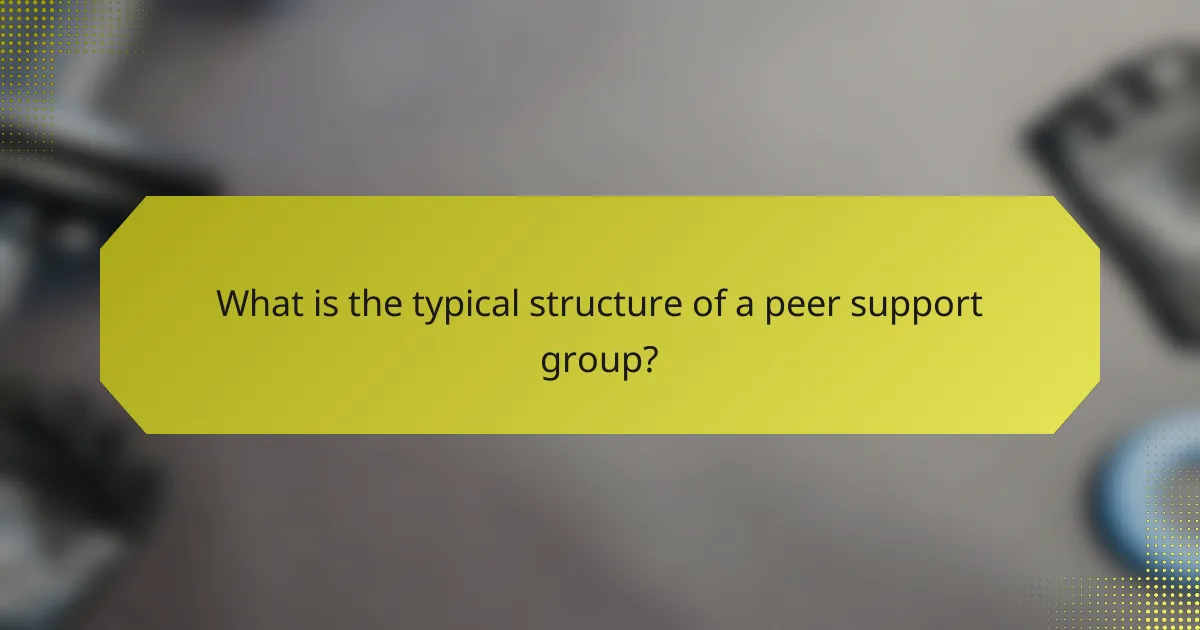
What is the typical structure of a peer support group?
A typical peer support group consists of a small, diverse group of individuals sharing similar experiences. These groups often follow a structured format that includes regular meetings, a facilitator to guide discussions, and established ground rules to ensure a safe environment. Members actively listen, share personal stories, and provide emotional support, fostering a sense of belonging. The impact of peer support groups on mental health can be profound, enhancing resilience and reducing feelings of isolation among participants.
What are the common formats for peer support groups?
Peer support groups commonly exist in several formats, each designed to foster connection and support among participants. These formats include in-person meetings, online forums, telephone support lines, and hybrid models combining both in-person and virtual interactions. Each format offers unique benefits, such as accessibility and convenience, catering to diverse needs within the mental health community.
What are the differences between in-person and online peer support groups?
In-person peer support groups foster direct human connection, while online groups offer flexibility and accessibility. In-person interactions can enhance trust and emotional support, whereas online formats can reach a broader audience, accommodating various schedules. Both formats have unique attributes that cater to different preferences and needs in mental health support.
How are peer support groups typically facilitated?
Peer support groups are typically facilitated by trained leaders or peers with lived experience. They create a safe environment for sharing, encourage open dialogue, and guide discussions to ensure everyone participates. Facilitators may use structured formats or themes to focus conversations, enhancing the group’s effectiveness. The unique attribute of these groups is their emphasis on mutual support, fostering connection and understanding among participants.
What guidelines ensure effective peer support group sessions?
Effective peer support group sessions follow guidelines that promote open communication, respect, and confidentiality. Establish a clear purpose for each session to guide discussions. Encourage active listening and empathy among participants to foster a supportive environment. Regularly evaluate the group’s dynamics to ensure everyone feels included and valued. Establish ground rules to maintain a safe space for sharing experiences and feelings.
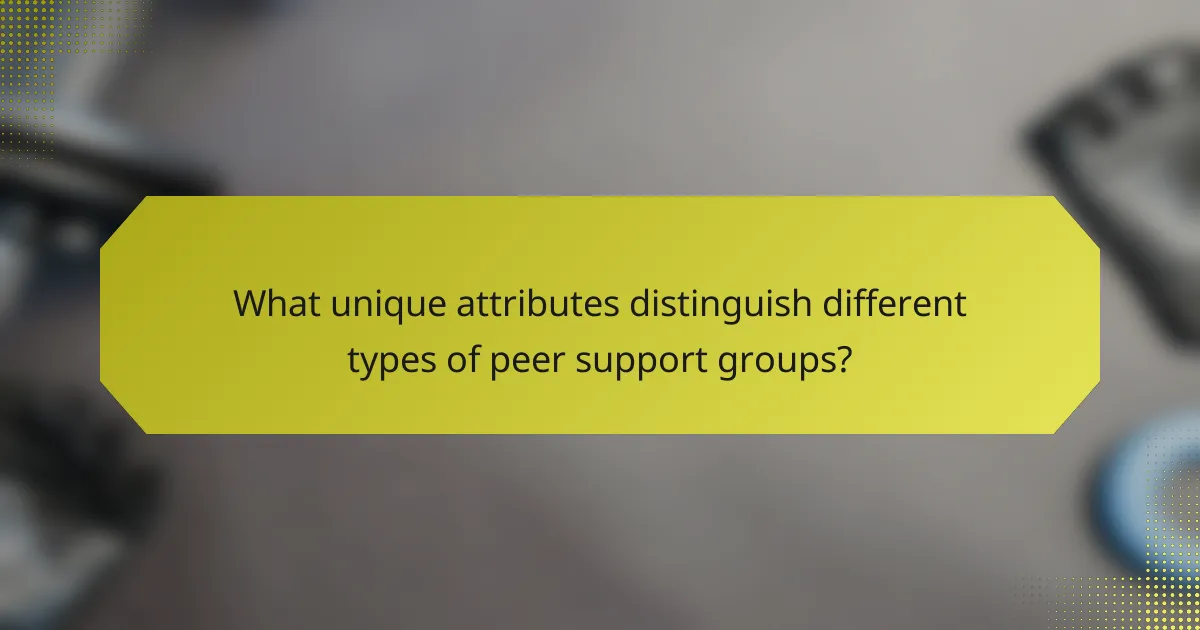
What unique attributes distinguish different types of peer support groups?
Different types of peer support groups are distinguished by their unique attributes, such as focus area, structure, and participant demographics. For example, support groups for addiction recovery emphasize shared experiences and accountability, while mental health groups may prioritize emotional support and coping strategies. Additionally, some groups operate under formal organizations, offering structured programs, whereas others are informal and community-driven. The diversity in these attributes allows groups to cater to specific needs, enhancing their effectiveness and impact on mental health.
How do specialized peer support groups cater to specific mental health issues?
Specialized peer support groups address specific mental health issues by creating safe spaces tailored to unique experiences. These groups foster understanding through shared challenges, enhancing emotional resilience. For instance, groups for anxiety disorders focus on coping strategies and anxiety management techniques, while those for depression emphasize support and motivation. This targeted approach improves participants’ mental health outcomes by providing relevant resources and community connections.
What are the characteristics of culturally specific peer support groups?
Culturally specific peer support groups emphasize shared experiences and values among participants. They foster trust and understanding, addressing unique cultural needs. These groups often incorporate traditional practices and languages, enhancing accessibility and relevance. Unique attributes include tailored communication styles and culturally relevant resources, which strengthen community bonds.
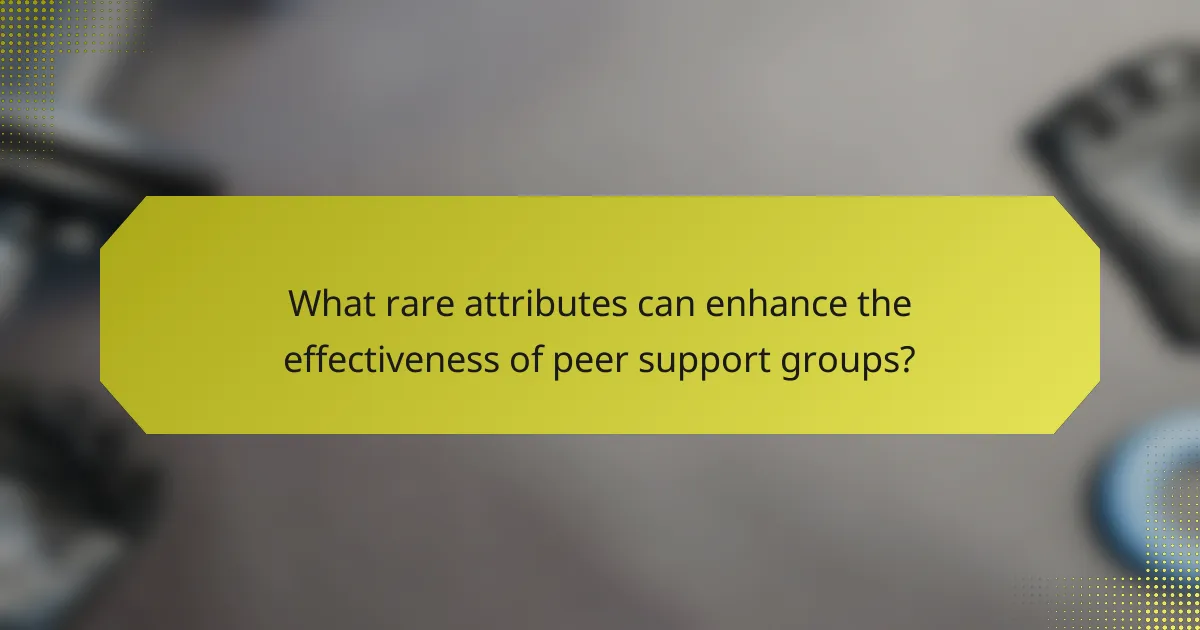
What rare attributes can enhance the effectiveness of peer support groups?
Rare attributes that can enhance the effectiveness of peer support groups include diversity in lived experiences, specialized training in group facilitation, and access to unique resources. These attributes foster deeper connections, improve communication, and provide tailored support, ultimately boosting the group’s impact on mental health.
How does the experience level of facilitators impact group dynamics?
Facilitators with higher experience levels positively impact group dynamics by fostering trust and engagement. Their skills enhance communication, leading to a supportive environment. Experienced facilitators can effectively manage conflicts, ensuring smoother interactions. This ultimately promotes better mental health outcomes for participants in peer support groups.
What unique success stories exist within peer support groups?
Peer support groups have numerous unique success stories that highlight their transformative impact on individuals. One notable example is a group for veterans struggling with PTSD, where members share experiences and coping strategies, leading to improved mental health outcomes. Another success story involves a support network for parents of children with disabilities, fostering a sense of community and shared resilience. These groups often create lasting friendships and provide a safe space for vulnerability, enhancing emotional well-being. The unique attribute of peer support groups is their ability to foster genuine connections, which can lead to significant personal growth and recovery.
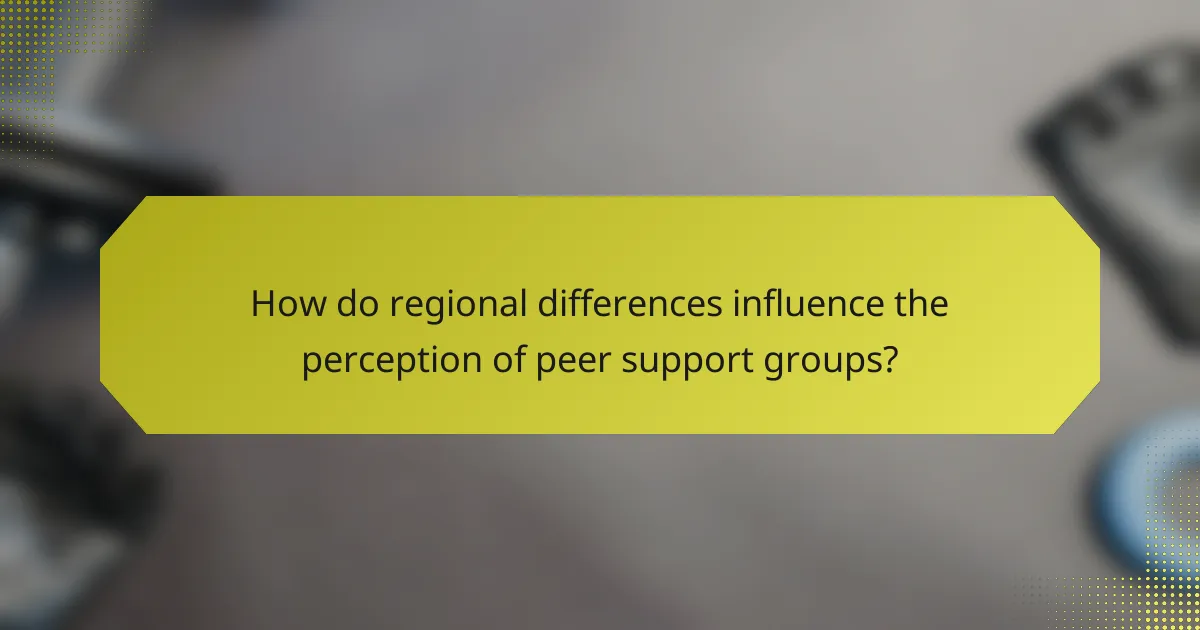
How do regional differences influence the perception of peer support groups?
Regional differences significantly shape the perception of peer support groups. Cultural norms and values influence how individuals view mental health and help-seeking behaviors. In some regions, peer support groups are embraced as vital community resources, while in others, stigma may hinder participation.
For example, in collectivist cultures, group support is often seen as essential for emotional well-being. In contrast, individualistic societies might prioritize personal resilience, affecting group dynamics. Accessibility also varies; urban areas typically have more resources than rural regions, impacting availability and engagement levels.
The unique attribute of regional language and dialects can also affect communication within these groups, fostering a sense of belonging or, conversely, alienation. Understanding these nuances is crucial for tailoring peer support initiatives to meet diverse community needs effectively.
What cultural factors affect participation in peer support groups?
Cultural factors significantly influence participation in peer support groups. Stigma around mental health in certain cultures may discourage individuals from seeking help. Additionally, cultural beliefs about emotional expression can affect willingness to share personal experiences. Social norms regarding community and family involvement also shape participation levels, as some cultures prioritize collective support over individual initiatives. Accessibility and language barriers further impact engagement in diverse communities.
How do local mental health policies shape peer support group structures?
Local mental health policies significantly influence the structure of peer support groups by establishing guidelines and funding sources. These policies determine the accessibility and availability of resources, which directly affects group formation and sustainability. For example, policies promoting inclusivity can lead to diverse group structures that cater to various demographics. Additionally, funding allocations can enhance training for facilitators, improving the quality of support offered. Ultimately, effective policies foster environments where peer support groups can thrive, enhancing mental health outcomes in communities.
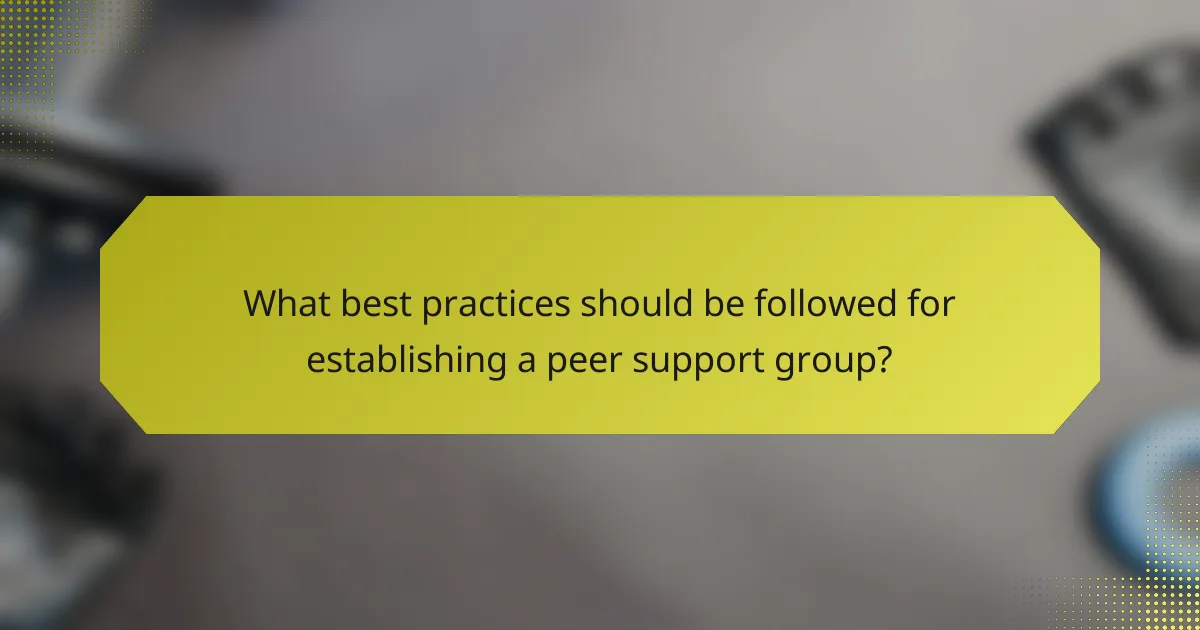
What best practices should be followed for establishing a peer support group?
Establishing a peer support group requires clear objectives, defined roles, and a safe environment. Begin by identifying the group’s purpose, such as emotional support or skill-sharing. Select a diverse team of facilitators who can guide discussions and ensure inclusivity. Create ground rules to foster respect and confidentiality among participants. Regularly evaluate the group’s effectiveness and adapt as needed to meet members’ evolving needs.
What common mistakes should be avoided when creating a peer support group?
Common mistakes to avoid when creating a peer support group include lack of clear purpose, inadequate training for facilitators, neglecting member confidentiality, and failing to establish group norms. These issues can hinder group effectiveness and member trust. Ensuring a structured format and open communication fosters a supportive environment.
How can peer support groups measure their impact on participants?
Peer support groups can measure their impact on participants through surveys, feedback sessions, and outcome tracking. These methods assess changes in mental health, social connections, and overall well-being. Surveys can quantify improvements in mood or coping skills, while feedback sessions provide qualitative insights into personal experiences. Tracking outcomes over time reveals trends in participant growth and satisfaction. This data helps refine group structures and enhance effectiveness, ensuring that support remains relevant and impactful.
What strategies can enhance engagement in peer support groups?
To enhance engagement in peer support groups, implement structured activities, foster open communication, and establish clear goals. These strategies encourage participation and create a supportive environment. Regular feedback sessions can also help tailor the group’s focus to members’ needs, increasing overall satisfaction and involvement.


